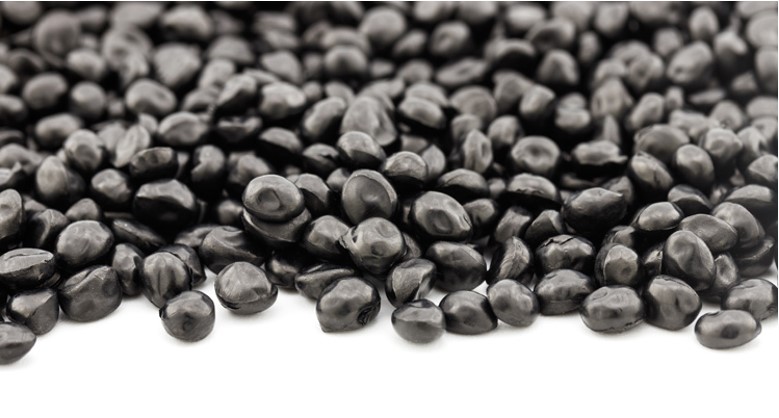
Carbon Black
Carbon black (acetylene black, channel black, furnace black, lamp black and thermal black) is a material produced by the incomplete combustion of heavy petroleum products such as FCC tar, coal tar, or ethylene cracking tar. Carbon black is a form of paracrystalline carbon that has a high surface-area-to-volume ratio.
Manufacturing
Carbon black is produced with the thermal decomposition method or the partial combustion method using hydrocarbons such as oil or natural gas as raw material.
The characteristics of carbon black vary depending on manufacturing process, and therefore carbon black is classified by manufacturing process. Carbon black produced with the furnace process, which is the most commonly used method now, is called “furnace black,” distinguishing it from carbon black, which is manufactured with other processes.
This method forms carbon black by blowing petroleum oil or coal oil as raw material (feedstock oil) into high-temperature gases to combust them partially. This method is suitable for mass production due to its high yield, and allows wide control over its properties such as particle size or structure. This is currently the most common method used for manufacturing carbon black for various applications from rubber reinforcement to coloring.
This method forms carbon black by bringing partially combusted fuel, which is generated with natural gas as raw material, into contact with channel steel (H-shaped steel) and then collecting the carbon black which results.
There are yield and environment issues around this method, and therefore has lost the leading role as the mass production process to the furnace process. This method, however, provides carbon black with many functional groups on the surface, being used in some painting applications.
This process obtains carbon black by thermally decomposing acetylene gas. It provides carbon black with higher structures and higher crystallinity, and is mainly used for electric conductive agents.
This method obtains carbon black by collecting soot from fumes generated by burning oils or pine wood. This method has been used since the days before Christ, and is not suitable for mass production. However, it is used as raw material for ink sticks as it provides carbon black with specific color.
Properties
The diameter of spherical particles is the fundamental property which largely affects blackness and dispersibility when carbon black is mixed with resins or other vehicles.
In general, the smaller the particle size is, the higher the blackness of carbon black becomes. Dispersion, however, becomes difficult due to an increase in coagulation force.
Like particle size, the size of the structure also affects the blackness and dispersibility of carbon black. Generally, the increase of structure size improves dispersibility but lowers blackness.
Carbon black with a larger structure in particular shows an excellent conductive property.
Various functional groups are combined on the surface of carbon black, by modifying the surface properties, we can change the compound characteristics.
The size of the aggregates (individual carbon black particles fused to other particles of a similar size) varies.
If the distribution is sharp, this indicates that there are many aggregates of the same size.
Compound characteristics
Reinforcement Carbon black is added to the rubber used in tire treads, to high-pressure hoses, and has other demanding applications, as well as added to plastics as material reinforcement.
Conductive carbon black is added to natural rubber or other materials to decrease their electrical resistance.
Carbon black has strong tint properties, it is heat stable and suitable for plastic and film coloring.
Carbon black’s absorption of ultraviolet light is excellent. Adding carbon black to other materials prevents ultraviolet degradation.
Application
Carbon black is a basic material with a long history, and it has been used as a coloring agent since the days before Christ. Since carbon black has nano-particles with various functions such as ultra-violet absorption and conductivity, it is still being applied to new fields such as electronic equipment and devices. Some applications of carbon black, which is a conventional yet new material, are shown below.
Carbon black has higher tinting strength compared to iron black or organic pigments, and is widely used for newspaper inks, printing inks, India inks, and paints. Carbon black is also used as black pigment for inkjet ink or toners.
Carbon black has high tinting strength and is thermally stable, and therefore it is suitable for coloring resins and films that are heat-formed. Carbon black is also excellent for absorbing ultraviolet light, providing both a superb resistance against ultraviolet rays and a coloring effect when just a small amount is mixed with resins. Carbon black is widely used for general coloring for resins and films. Resins with carbon black are used in automobile bumpers, wire coverings and steel pipe linings which require weather resistance in particular.
Carbon black particles have the graphite-type crystalline structure, providing an excellent electric conductivity. Therefore, carbon black is widely used as conductive filler, being mixed in plastics, elastomer, paints, adhesives, films, and pastes.
Fuel caps and fuel-introducing pipes of automobiles, for example, are required of electric conductivity for preventing static. Therefore, carbon black is used as an excellent antistatic agent.
Get a Free Quote
Other Products

Tulsiram Hanumanbagas Gilada (THG), is a leading trade house for Synthetic Rubbers and Rubber Chemicals. Established and Lead by Mr Ramakant Gilada 3 decades ago at Hyderabad and later expanded to all over South India.
Contact Us
- thghyd@gmail.com
- +91 7893883141
Copyright © 2024 Tulsiram HanumanBagas Gilada. All Rights Reserved.

